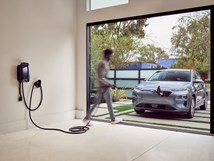Toyota Tests Improved Solar Panels to Charge EVs
Toyota Motor Corp. has begun testing a Prius Prime plug-in hybrid sedan fitted with next-generation solar panels on the hood, roof, rear window and spoiler.
#hybrid #electronics
Toyota Motor Corp. has begun testing a Prius Prime plug-in hybrid sedan fitted with next-generation solar panels on the hood, roof, rear window and spoiler.

The photovoltaic cells developed by Sharp Corp. are thinner and more efficient than the roof-mounted Panasonic units currently offered on the Prius in select markets. That system—which helps power auxiliary components while the car is running and cab partially recharge the battery when parked—boosts fuel efficiency by as much as 10% on sunny days.
The new Sharp cells have an efficiency rate of 34% and can generate about 860 watts of electricity, according to Toyota. This compares with 180 watts and a 22.5% rating for the current Panasonic array.

During initial tests, the new solar panels added 35 miles of electric range to the Prius demonstration vehicle. But Toyota says performance is significantly less on cloudy days.
The new solar cells are about 0.03 mm thick, which Toyota says allows them to be form fitted to the car’s body panels. The overall system adds about 180 lbs to the car.
Toyota officials tell Reuters that production applications are “years away.” Significant cost and weight reductions are needed before that happens, they acknowledge.
RELATED CONTENT
-
Chevy Develops eCOPO Camaro: The Fast and the Electric
The notion that electric vehicles were the sort of thing that well-meaning professors who wear tweed jackets with elbow patches drove in order to help save the environment was pretty much annihilated when Tesla added the Ludicrous+ mode to the Model S which propelled the vehicle from 0 to 60 mph in less than 3 seconds.
-
Startup Readies Solar-Powered EV
Germany’s Sono Motors GmbH says it has received 5,000 orders for its upcoming Sion electric car, which can be partially recharged by it attached solar panels.
-
About the 2020 Lincoln Aviator
Successful vehicles tend to be those that are available on a global basis, and increasingly, those vehicles tend to be in the SUV segment writ large.








